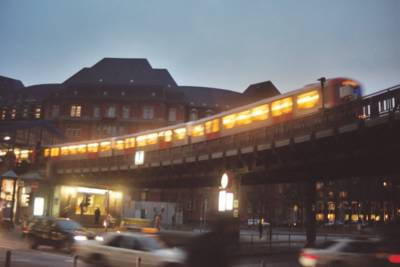
Hamburg Streets
It was only one afternoon, but an afternoon was all I needed to explore Hamburg. My mission was simple: go cathedral hunting. But to start, I sought coffee to revive me from the jetlag. In serendipitous fashion I came across a tiny church run coffee shop called Das Kirchencafe, at the base of the closest cathedral, St. Jacobi. I indulged in one of those miniature European espressos. It was just enough to kick me back in gear. I walked out into a gray and overcast day, and the wet air was the type you’d expect in northern Germany: hardy, thick, and heavy. It was an apt day for a leisurely stroll in the city.
The city of Hamburg was built on a port where water holds an important value. This is represented in a statue depicting a man carrying two buckets of water. Replicas of this same statue riddle the street corners of Hamburg. The man represents the people of Hamburg. And as history points out, these people made daily pilgrimages to the port's waterways to draw water and carry it back to their families for use. The statues are commissioned pieces of art, uniquely painted, each telling an individual story.
In Hamburg, the waterways are abundant and I walked a dozen footbridges over a series of canals that flowed through the city. Along the wider canals, colorful boats shamelessly cruise the rivers, proudly waving German flags. City buildings line the canals, except they don’t rise up like skyscrapers, they prefer to lie down alongside the rivers edge in one massive complex of a building stretching several city blocks long. The modern steel and brick structured buildings house countless shops. They share space with old wooden framed buildings, a faint reminder of old Europe.

One of the Many Canals
In essence, Hamburg is a juxtaposition of an old and new world. That's because in 1842, a fire broke out in a house on a little street: 25 Deichstrasse. The fire raged along, decimating the city in its entirety. And while most of the city was destroyed by the fire, some of it was salvaged and rebuilt. This did not last long, especially in 1945, when the allied bombs destroyed Germany. I stumbled upon the remains of one of these churches, St Nikolai. It’s an empty shell of what once was a cathedral of gothic beauty. I walked through the side door and found no shelter from the drizzling rain, it was only a hallway with no ceiling. All that remains is a lonely tower that arches high into sky with an exposed floor of ruins surrounding it. It serves as a simple reminder of the cruel effects of a war that crippled Germany.

St. Nikolai Tower
A few blocks away I spotted the clock tower of St. Michaelis cathedral. I navigated my way through an old neighborhood and up through a passageway that opened up to the church. Inside, I lit a candle at the altar, prayed for my family, and decided to climb the clock tower. Instead of taking the lift, I opted to brave the stairs and climb the 10 or so stories. It was a lonely dark climb where only steel support beams and concrete welcomed me. I felt like Jonah lost in the belly of a whale as each grueling step echoed on the cold steel in the belly of this beast. The climb took every breath out of me. At the top, I could see a sliver of light cracking through heavy iron doors, which broke open to reveal a platform offering a 360 degree panoramic view of Hamburg. The hazy gray sky made it hard to see far, but I could at least make out the ghosts of other churches in the distance.
After the tiresome walk through the city, I began to get hungry and decided to stop in the very spot where the 1842 fire began, Zum Brandanfang (the fire’s beginning) for some Konig Pilsner Beer and true German cuisine. I recommend the potato soup, fish filets with roasted potatoes, and the German cabbage. It all goes quite well with the beer. Zum Brandanfang is a charming place reminiscent of an old smoky bar with dark hickory bench seats. The cook passes food through an 18 x 24 inch sliding wood window, like those you might find in a dungeon where a prisoner receives his daily bowl of gruel and stale bread. Here the waitresses are girthy in a stereotypical German woman kind of way. They serve up patrons laughing, speaking in thick German accents, spilling beers, and smoking cigarettes. I sat there into the evening getting full, staring through the smoke filled room, focusing on the burning cigarette someone left in an empty ashtray. I got lost in a daze - jetlagged & daydreaming - all but convinced that the 1842 fire got started in a scene just like this one.
- Marvin A.
3 comments:
I found this useful insofar that I was actually writing a section of my novel that involved a train passing though Hamburg and I didn't have a clue what the place was like so it was mostly guesswork.
At least now I can write that part with some sort of sense of authenticity, so thanks.
I love the discription of the view from the top of the church tower: the 'ghosts of other churches'. And the comment about the 'girthy' German women. Quite a mental picture. One of the best blogs yet!
I love your blog - you have some cool adventures - I especially like what you said about 3 types of people - I put it in my blog - if that's not okay - just let me know and I'll take it off. I am a collector of words of wisdom.
Post a Comment